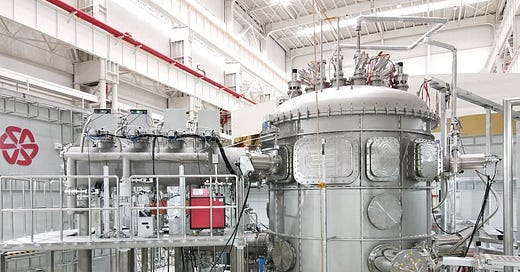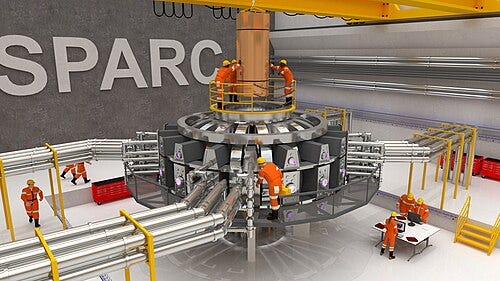The first electricity generated by controlled nuclear fusion must come from our country, and we are working towards this goal. Lu Tiezhong, Chairman, China National Nuclear Power, September, 2023.
Amid growing concerns over a world energy crisis, controlled nuclear fusion1 is viewed by experts and industry as the ultimate solution to humanity’s need for infinite, clean, cheap energy. Once science fiction, it’s now a ferociously competitive field, as teams worldwide compete to make it a reality. Yet our media are ignoring the most exciting scientific news of this century
The Technology
The most popular approach to fusion energy uses tokamaks, whose superconducting magnets generate powerful fields that confine hydrogen atoms so that they fuse into heavier atoms and give off excess energy in the process.
In 2007 a multinational consortium raised $20 billion to build ITER, a tokamak2 fusion-containment reactor to demonstrate fusion plasma in 2026. ITER chose exotic, low-temperature superconductors to cool its magnets, their astronomical cost, complexity, bulk, and massive amounts of energy for cooling discouraged Chinese scientists at ITER, but their experience created a large talent pool of outstanding fusion engineers.
In 2001, Energy Singularity Corp3, a private Shanghai company, raised $1 billion to build HH7, a tokamak fusion-containment reactor. Energy Singularity chose cheap, high-temperature superconductors, HTS, to generate stronger magnetic fields in smaller, cheaper, faster machines than ITER’s and its first tokamak, HH7 achieved a plasma density4 high enough for commercial goals last month. Yasmin Andrew, a nuclear scientist at Imperial College London, said several private companies (Bill Gates funds one) are working on fusion, but HH70 is the first tokamak to achieve a plasma.
Energy Singularlity’s CEO Yang stressed that using high-temperature superconducting materials can reduce the volume of a device to 2% of that of traditional low-temperature superconducting devices, and shorten the construction period from the original 30 years to 3-4 years to build a tokamak device with a Q>10 (a ten-fold return on power, or 500 MW of fusion power from 50 MW of input power. COO Ye Yuming promised that their next reactor, HH170, will be the smallest, cheapest tokamak capable of achieving a 10-fold energy gain. Its field strength will be 110% of SPARC and its volume 70% of SPARC (the MIT tokamak above), enabling further cost reduction.
MIT’s Dennis Whyte says the domestic supply chain and technology development are critical as fusion technology advances, “It is no longer just studied for science’s sake but is pivoting towards implementation as a new energy source”.
The exotic HTS tapes in the HH70, for example, come from Shanghai Superconductor, a global supplier since 2011 and one of six that mass-produces HTS tapes. This year, Energy Point Corp, another member of the fusion supply chain, will deliver 25 Tesla, D-shaped high-temperature magnets – ten times stronger than HH70’s 2.5 Tesla magnetic field, and construction of HH170 will begin next year. Work on a tokamak fusion power plant, HH380, will begin around 2030.
New energy, new industry
Significantly, 93% of the high-temperature superconducting tokamak was sourced from China’s domestic fusion industrial chain and 100% of its IP is entirely indigenous.
China’s Secret Sauces
Andrew Holland, CEO of the Fusion Industry Association, fears that the fusion industry will follow the pattern of the solar industry, where manufacturing came to be dominated by China. “It’s very clear that China has ambitions to do the same thing, both in the supply chain and in the developers,” he said. “It’s time for the US to respond to this challenge”.
But China’s consistent policy support, generous funding, domestic supply chain, large-scale manufacturing experience and vast, highly educated workforce give the country an immense, first-mover advantage in the engineering implementation of nuclear fusion technology and, potentially, creating a new era of sanity and joy.
Hydrogen Bombs are unconfined nuclear fusion events.
Russia created T-1, the first tokamak, in 1958.
Energy Singularity was established in Shanghai in 2021, focusing on commercially viable high-temperature superconducting tokamak devices and their operational control software systems. The company's shareholders include miHoYo, developer of Genshin Impact, and EV maker, NIO.
The higher the density the more nuclei packed together, increases the chances of a fusion event. “Plasma density is the Goldilocks factor in nuclear fusion: too low, and the fusion reactions won't happen, too high, and the plasma becomes unstable. Finding and staying in the sweet spot is essential for achieving the high-energy-density plasmas needed for sustainable fusion power”.






Great news. China's EV industry will have noticed.
Very interested to know the way chosen to convert Plasma Energy to AC Electricity.
This is a very specific “CHINA” break-through in fusion technology,
not sure why the term “Asian” break-through was used instead.